Idli recipe: wondering how to make soft idli with homemade idli batter? Look no further for the perfect formula and tips for making soft idlis!
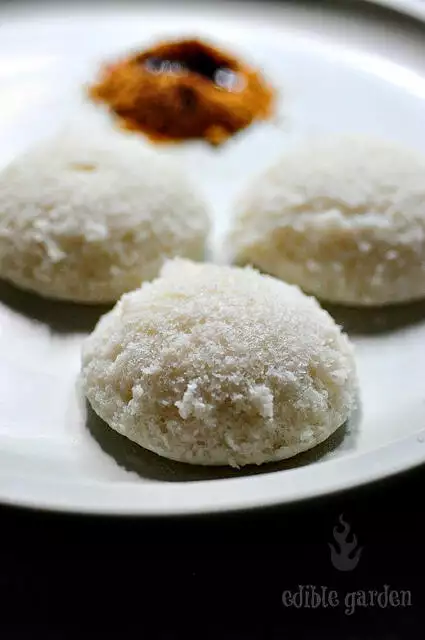
Idli and dosa is a staple breakfast for most South Indians. In my home, we always have the batter ready in our fridge and Amma is always prepared to feed multiple people for breakfast or dinner at minutes’ notice, thanks to this.
Amma has a large, old-fashioned grinder which we’ve had ever since I can remember. In my childhood, we moved houses 6 times and this grinder came with us from house to house, year by year, doing its job as expected. Ok, I will stop now, I don’t want to jinx it!
So yeah, back to idli and dosa. My maternal grand mom, as long as she was able to, oversaw the grinding of the idli-dosa batter and she did it with a hawk-eye. The help will handle the measuring and soaking and actual grinding and the heavy-lifting (quite literally) of using the stone insert in the middle of the grinder, and finally the onerous task of cleaning the thing once the batter is ground. Needless to say, except for passing by a couple of times and wondering how it would feel to dip my finger into the creamy batter, I have had nothing to do with this idli batter grinding business.
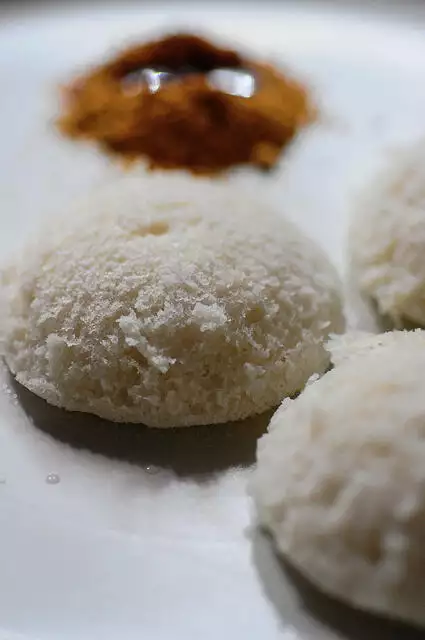
When I moved to Hyderabad for my first job, I started buying idli batter. Making idlis with store-bought batter hasn’t worked for me yet. I have tried a few times always knowing it will fail and it always has. Making dosa is easier since it’s more forgiving. But idlis are demanding. For all this, I am not even that fond of them!
Also check out rava idli, rava idli with eno, and instant oats idli. Don’t forget chutney recipes, you do need something to serve your soft and delicious idlis with.
Once I got married and moved to Singapore, I was ready to grow up and start making my own batter. I brought back a small, table-top wet grinder from back home (Trichy, to be exact) and it was a proud day I ground my first batch of idli batter.
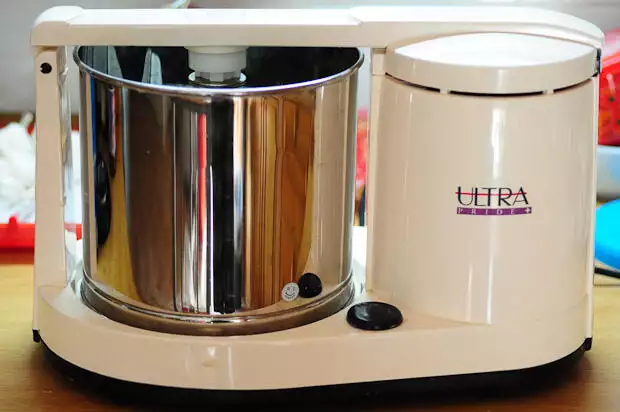
It was a disaster! The batter didn’t ferment at all and I should have taken that as a sign but it smelled fermented so I impatiently brought out the idli moulds and went the whole way. The idlis were rock hard. Dosas the next day turned out fine but the soft, pillowy idlis of my childhood had evaded me the first time and I was determined to not let that happen again.
But it did. I got it wrong about 3-4 more times. I did get marginally better at it each time but the idlis were nowhere near soft and barely edible if not dunked in litres of sambar.
I changed everything I could – the urad dal (I even brought back a kilo from Amma’s stash in Kottayam), the rice, adding salt at different times, fermenting spot, everything!
Then I realised the answer was really simple. It’s water. Yes, water. Not the type of water but the amount. I was not adding enough. It was a revelation when I realised this and since then, there has been no looking back. I make idli batter every 2 weeks and steam batches of idli and either chill them or freeze them for later use during those weekend mornings and too-tired-to-cook weeknights.
Also check out the Murugan Idli Kadai Idli Recipe.
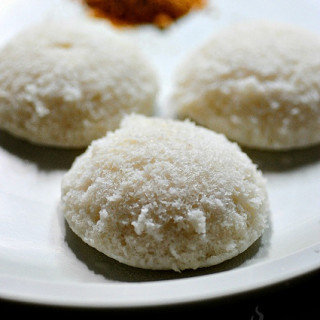
Idli Recipe: Idli Batter for Soft Idli
Ingredients
- 1 cup of whole skinned urad dal / ulutham paruppu / uzhunnu parippu
- 4 cups of idli rice
- Salt as needed
- Water as needed
- A wet grinder or powerful blender
Instructions
Step by Step Pictures to Make Idli:
- Wash the rice until the water runs clear. Soak in enough water to cover it by 3 inches and leave aside for 3-4 hours.
- Once the rice has been soaking for 2.5 to 3 hours, wash the urad dal and soak it for 30 mins or so. Amma tells me soaking urad dal for too long is not necessary and it may lose its "potency". Make sure there's enough water for it to absorb and swell - the urad dal requires more water than the rice.
- Wash and prepare your grinder. Add the soaked urad dal...
- and a generous amount of water to get it started. I usually add about 1 cup and see how that goes but this will totally depend on the quality of urad dal you use. My recurrent mistake was always not adding enough water to grind the urad dal.
- It will take about 15 mins for the urad dal to be ground smooth. When you take a little batter and rub between fingers, it should be smooth and flowy. As the urad dal grinds, it will rise and turn fluffy. This is perfect.
- Transfer the urad dal batter to a large enough container and set aside. You don't have to wipe the grinder clean of the batter. When you grind rice, it will automatically get 'cleaner'.
- In goes the soaked rice next.
- Rice doesn't need as much water as the dal so add about 1 to 1.5 cups and see if it gets thick as you grind. When rice grinds, it will absorb the water so test in between and keep adding water as you go, a little at a time. Grind rice to a smooth pate too and this takes me around 25 mins or so in my grinder.
- Once done, add this to the urad dal batter and top off with some salt. Mix gently so that the rice and dal get combined well.
- The consistency should be fluffy and the batter should fall down easily from your spoon as you mix it.
- Set aside this batter in a container that is only filled halfway with the batter to allow room for rising during fermentation.
- The urad dal would have risen to the top leaving the heavier rice batter at the bottom so you need to mix it uniformly before making idlis.
- Pour into greased (I use gingelly oil or Indian sesame oil) idli moulds and steam for 10-12 mins for super soft and spongy idlis.
Step by Step Pictures to Make Idli Batter and Soft Idli:
1. Wash the rice until the water runs clear. Soak in enough water to cover it by 3 inches and leave aside for 3-4 hours.
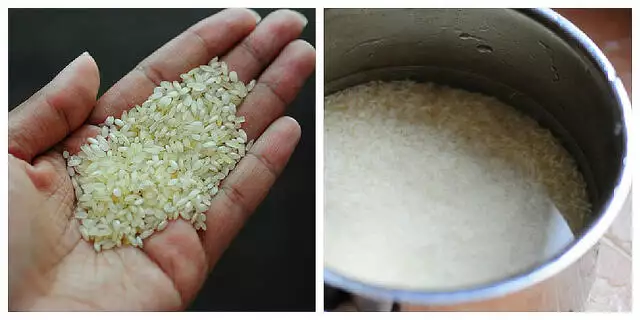
2. Once the rice has been soaking for 2.5 to 3 hours, wash the urad dal and soak it for 30 mins or so. Amma tells me soaking urad dal for too long is not necessary and it may lose its “potency”. Make sure there’s enough water for it to absorb and swell – the urad dal requires more water than the rice.
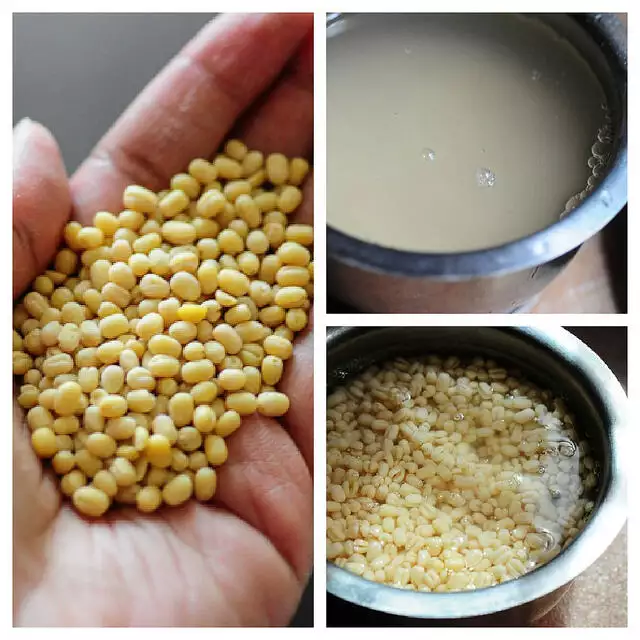
3. Wash and prepare your grinder. Add the soaked urad dal…
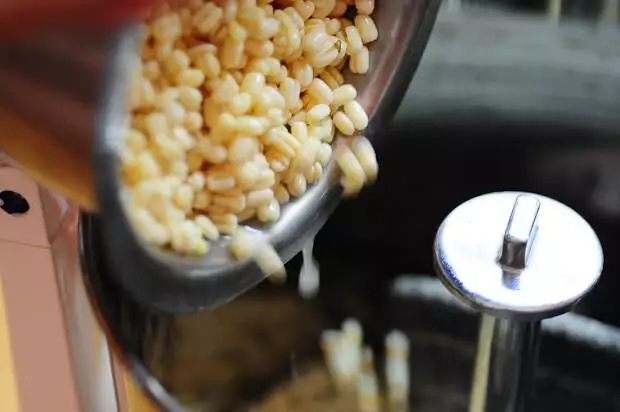
… and a generous amount of water to get it started. I usually add about 1 cup and see how that goes but this will totally depend on the quality of urad dal you use. My recurrent mistake was always not adding enough water to grind the urad dal.
It will take about 15 mins for the urad dal to be ground smooth. When you take a little batter and rub between fingers, it should be smooth and flowy. As the urad dal grinds, it will rise and turn fluffy. This is perfect.
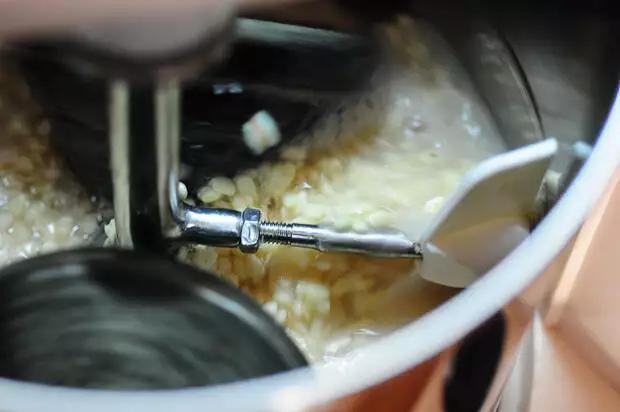
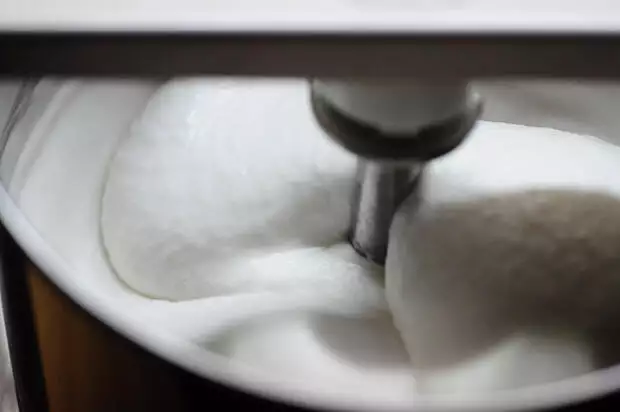
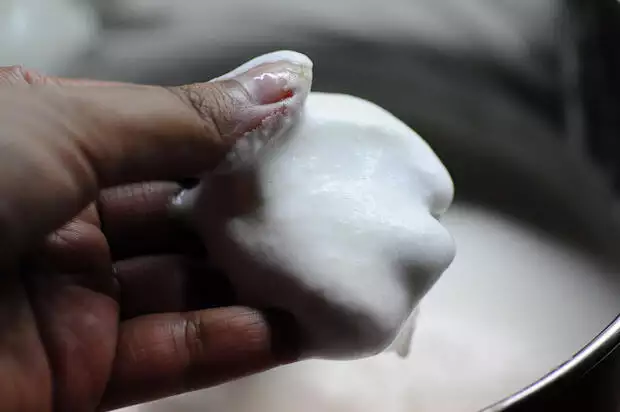
4. Transfer the urad dal batter to a large enough container and set aside. You don’t have to wipe the grinder clean of the batter. When you grind rice, it will automatically get ‘cleaner’.
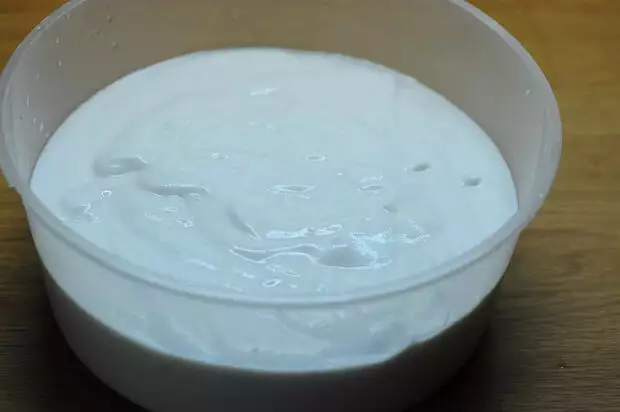
5. In goes the soaked rice next.
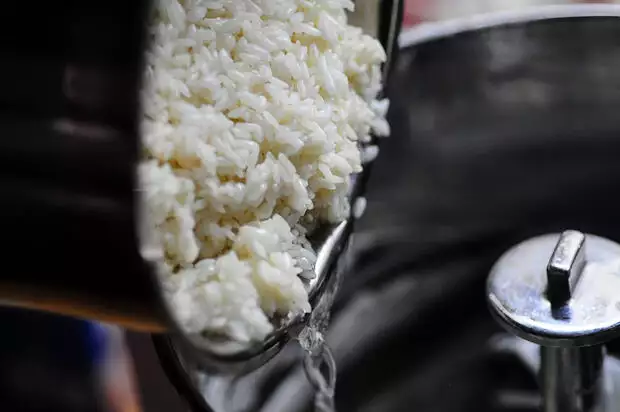
Rice doesn’t need as much water as the dal so add about 1 to 1.5 cups and see if it gets thick as you grind. When rice grinds, it will absorb the water so test in between and keep adding water as you go, a little at a time. Grind rice to a smooth pate too and this takes me around 25 mins or so in my grinder.
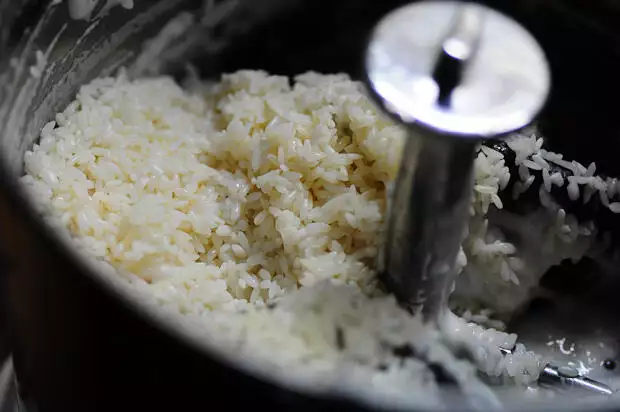
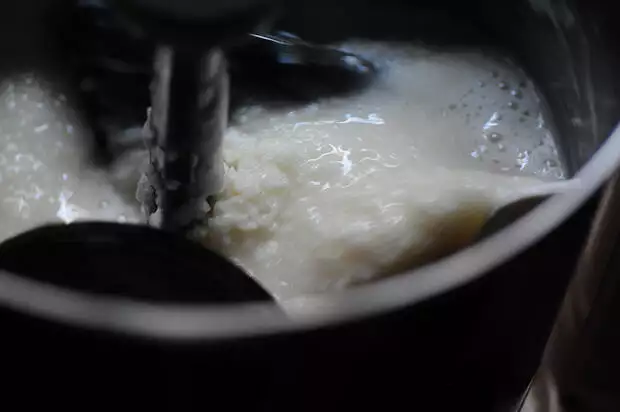
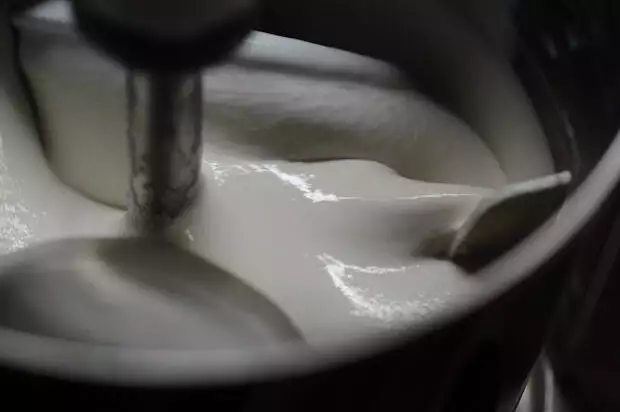
6. Once done, add this to the urad dal batter and top off with some salt. Mix gently so that the rice and dal get combined well.
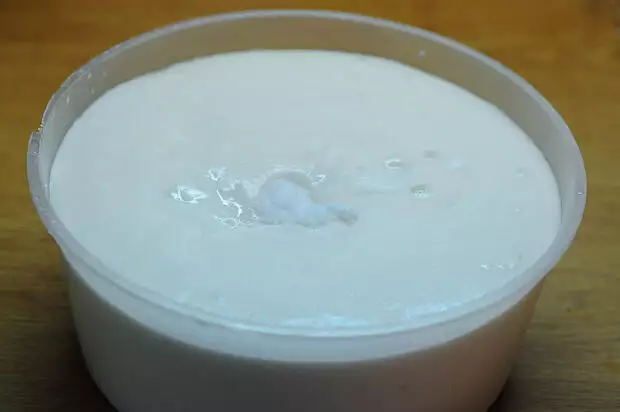
The consistency should be fluffy and the batter should fall down easily from your spoon as you mix it.
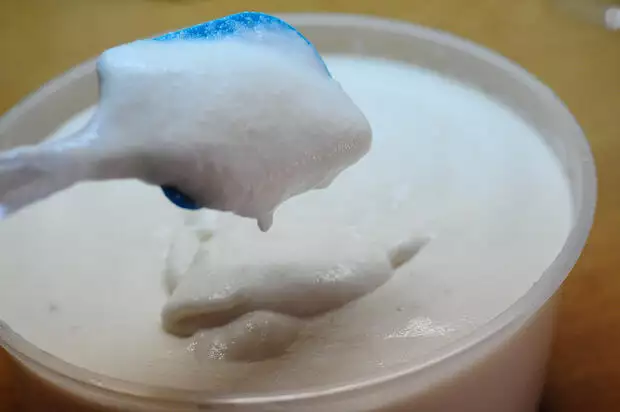
Set aside this batter in a container that is only filled halfway with the batter to allow room for rising during fermentation. Singapore is warm enough for us to leave it aside in the kitchen and it will ferment in about 6-8 hours. In colder places, you can either leave it inside the microwave (don’t turn it on!), or inside the oven with the oven light on. This is how most people I know in the US do it.
Once fermented and risen, mix very gently to combine. The urad dal would have risen to the top leaving the heavier rice batter at the bottom so you need to mix it uniformly before making idlis.
Pour into greased (I use gingelly oil) idli moulds and steam for 10-12 mins for super soft and spongy idlis.
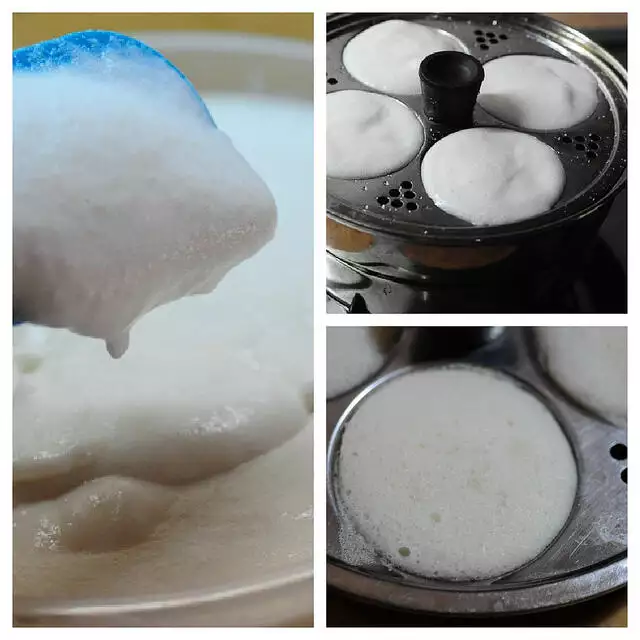
A few tips, notes, and learnings from me:
– I can’t stress the importance of adding enough water while grind the dal and rice. This is the single most important thing that separates you from soft idli.
– You can add some fenugreek seeds / methi seeds when soaking the rice. It gives a nice fragrance to the batter.
– I have tried soaking and grinding the rice and dal together (because I get immensely lazy sometimes). I got mixed results. Sometimes it worked ok and sometimes not. Again, dosa always turns out fine so if you don’t intend to make idlis, you can take this shortcut.
– Once you have scraped out all the rice batter, wash the grinder with little water and collect this in a separate bowl. After a few hours, the batter in the water will sink leaving almost-clear water on top. I add this to the batter before making dosa because for dosa we need to water down the batter anyway. My grand mom was very frugal when it came to cooking and she would do this so that we don’t even waste the batter sticking to the grinder.
– Always use a wet spoon to remove idlis from the mould and do it after the idlis have cooled down a bit.
– Once the batter is fermented and you have made idlis, store the batter in the refrigerator. You can make dosas from day 2 onwards by diluting the batter to the right pouring consistency. On day 4 and 5, if I still have batter left, I make masala kuzhi paniyaram.
– I make idlis in bulk and store in them steel containers in the chiller (if I plan to use them within the week) or in the freezer (for longer storage). Before serving, the best thing to do is to re-steam them for a quick 5 mins but if you don’t want to do that, re-heat them in the microwave with some water sprinkled on top. These have to be served immediately, otherwise they will turn hard and rubbery.
– If using a mixie or blender for grinding idli-dosa batter, remember that it won’t get you the same results as a wet grinder. Also, reduce the quantity of rice:dal and use 3:1. I use my rice cooker cup to measure, you can use any cup or tumbler as long as you use the same one to measure both rice and dal.
– If your idlis are too flat, it could be due to two reasons. One, there’s too much urad dal in the batter and two, the batter is too watery. Even if you end up adding too much urad, if your batter is thick, the idlis will be fine but too much water will create flat idlis and there’s really no way to fix this. The idlis will still turn out soft in most cases though.
– UPDATE: If any of you are using a mixie or mixer-grinder to grind your idli-dosa batter, then here’s a note from Vini who does the same in her Preethi mixer-grinder. The proportions are as I mentioned, 3:1 rice:urad dal but see how important the addition of enough water is. Read her note below. For anyone wondering “can you grind idli-dosa batter in a mixie or mixie-grinder?” Here’s your answer.
“Hey Nags,
I am glad I came across this post! I have only a mixer ever since I shifted to the US. The ladies of my house gave me several tips to make idli-dosa batter in a mixie including 3:1rice dal, mixing with hands, switching on then oven light but no one ever told me the importance of adding enough water! I always used to get ok-ok idlis and I blamed it on the mixie and was waiting to ge a grinder soon. But but I saw this awesome post and immediately soaked rice and dal..made sure I added sufficient water while grinding..the batter fermented beautifully and voila my idles where super soft just like how mom makes it back home :):) I jumped in joy when hubby told they were the best idles he had eaten since he came to the US 🙂 Thank you so much for this important tip which no other blog post on idlis stressed about. And you can tell everyone that soft idles are possible with preethi mixer grinder :)”
How do you make idli batter at home? What do you do differently and what has worked? Please leave a comment with your idli and dosa tips please!
For idli recipe and idli batter instructions in Hindi, Tamil, Telugu, Kannada, Urdu, etc please use the Google translate button in the sidebar.
If you try making idli at home using my recipe and instructions, do leave a comment and positive rating below. You can also share pictures on social media with #ediblegarden, I’d love to see them!

My idlis get stuck to the moulds.When I take them out they look like lumps of cooked batter.I steam them for more tham 15 minutes.Am I overcooking them ?I also add poha to the batter.1 cup dal, 2 cups idli rice ? 1 cup poha.
make sure you grease the moulds with oil and also steam in medium-low flame so that the idlis get cooked evenly
This is incredibly helpful, thank you! I got the same wet grinder as an Xmas present two years ago, tried once and was so ashamed of my failure that i put it in a cupboard and ignored it.
The water makes so much difference. I do have one question – I also have a new pressure cooker and I’ve seen some things saying that it can be good to pressure cook them. Have you done this? Does it matter? Does it even work?
Thanks again!
You mean pressure cook idlis? You can use pressure cooker to steam idlis. Place water in the cooker, insert the idli moulds, close and cook for 10-12 minutes. Do not use the “weight” on top.
very nicely presented.. thank you .. my wife Lav preparing dosa since 5 years she did not knew batter measure at all after reading this artical she started preparing nice soft idle and soft dosa.. thank you again
Thank you, so glad it helped.
Thanks for your k
Hi all,
Here is an amazing idea for soft fluffy idlis which I regularly use while I always grind my batter at home in a mixer grinder neither do I soak both rice and dal separate nor do I grind them separate since years and never faced any difficulty . The idea is very simple just take some cooked rice if available while grinding if not just take thick poha soak it for 5minutes while you grind the soaked rice and uraddal then grind it along with the rice and urad dal. Now put required amount of salt and keep for fermentation near your cooking area as the heat helps to ferment. Once fermented soft fluffy idlis are ready to be served.
Thank you Neetha 🙂 I have a recipe called “Murugan Idli Kadai Idli Recipe” in this site and it uses this method of adding cooked rice to dosa batter (or idli batter). works perfectly!
Hi,
Follow your blog for loads of recipes (making green chilli chicken and palak pulao today 🙂
Just a query, what is the exact model of grinder that you have? Currently trying to source some company that will ship to me in Spain without charging the earth…
Wow! Thanks to you – I just made my best idli ever! Have been looking for similar tips since long and finally found it here! First time, my idlis were not soggy or hard – perfect!! 🙂 I am so happy!
This really is an eye opener Nags ! I live in the UK and I get a very hard time getting good batter at home.. I am very hopeful for my next attempt now after reading this 🙂
I have seen dozens of cooking sites but Edible Garden is unique perhaps it is the organization, perhaps it is the photographs, and perhaps it is the quality of the recipes. I plan to be a frequent visitor and scale other mountains [OK, hills :-)] in cooking so to speak, using this site. I have already identified the next goal — that would be thogayal/chutney. I have failed in this before.
Here is where I stand on idly:
1. My wife and I each tried two times so far — with one success each. (During the work week, we live in two different towns.) The failures were due to (among other things possibly) not covering the batter while leaving it to ferment in the oven. The pilot lamp worked — unfortunately, a thick crust formed at the surface.
2. Here are the details of my successful recipe. (This worked in the US midwest, on cold days.)
1/4 cup whole ulundu (I was just testing the recipe), soaked overnight with 1/2 tsp of vendhiyam
1/2 cup rice rava soaked
Ulundu/vendhayam was blended to a fine paste. Water was squeezed out from rice rava. One handful blended into a coarse paste along with some cooked rice. [I use the proportion from Show Me The Curry. I also looked at vah reh wah.com] The two pastes were mixed and the rest of rice rava added to this. [This recipe is simpler than Edible Garden's. The latter my well taste better.]
I first let the batter to rise near the water heater for 12 hours. It did not rise. I then covered it with seran wrap and kept it overnight in the oven with the light on. To my pleasure and surprise, the batter rose. It was very frothy — the density was low. I mixed it by hand and then made the idly.
My wife used a similar procedure. She didn't keep it near the water heater and straightaway put it in the oven.
Hi Nags
My 18 month son is a fan of idli. He will grab one and eat it while playing and reading books. But I was always in doubt that I can ever make idlis with rice and dal and that too super soft. But after reading your post and tips I thought why shouldn't I give a try.
And today after days of prep (specially bought idli rice, soaking, grinding, re-reading post) I have come up with a batch of SUPER-DUPER soft idlis. Thanks to you only.
I am in a very cold area of US. But with your tips and my patience I am flying on cloud nine. And I really want to share pics with you but at the moment I am sharing on FB only 🙂
Again thanks a lot.